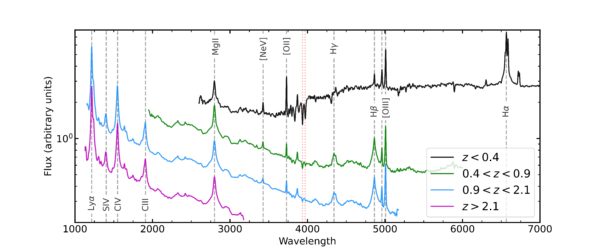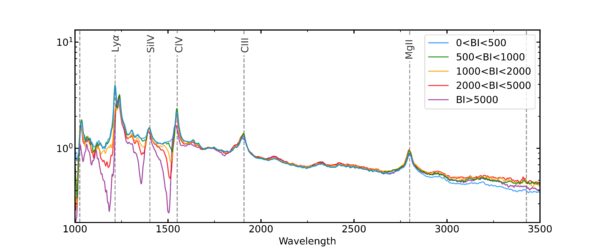Victoria Fawcett, Durham University
July 22, 2021
As the main DESI survey gets truly underway, I want to reflect on the amazing quality of the DESI quasar spectra observed so far. Quasars are incredibly luminous types of Active Galactic Nuclei (AGN), which consist of a supermassive black hole at the centre of galaxies, surrounded by a disc of matter that often outshines the entire galaxy. Quasars are one of the brightest objects in the Universe and are really important in all areas of Astronomy, especially Cosmology.
With over 30,000 quasar spectra observed so far, DESI is already pushing beyond what previous spectroscopic surveys have achieved. The image shows these ~30,000 spectra stacked in different bins of redshift, with the lowest redshift bin (z<0.4) corresponding to the objects closest to us. The dashed lines indicate the main emission lines in the spectra, each of which provide important information about the nature of the object: for example, the Oxygen lines can be used to study outflows close to the supermassive black hole. The clarity of the spectra and different lines really highlights the amazing quality of the data—the two red dotted lines show galaxy absorption lines, so we can even clearly see the affect of the surrounding galaxy!

Other exotic objects such as Broad Absorption Line Quasars (BALQSOs), systems known to host powerful outflows, have also been found within DESI (see image below). The dips to the left of the CIV, SiIV and Lya line are called BAL “troughs”, which deepen with increasing “balnicity index (BI)”; a measure of the strength of the trough. Studying these systems may be really important for understanding the processes that connect AGNs and their host galaxies.

DESI also pushes to fainter and more obscured systems which have been difficult to observe with shallower spectroscopic surveys. Quasars enshrouded by dust (“red quasars”) may represent an important phase in galaxy evolution so understanding their properties is crucial – these are the objects I am most interested in!
With millions of more quasar spectra to come, the future of quasar physics looks bright. I personally look forward to analysing the data and exploring all the weird and wonderful objects DESI has to offer.
